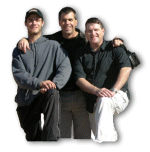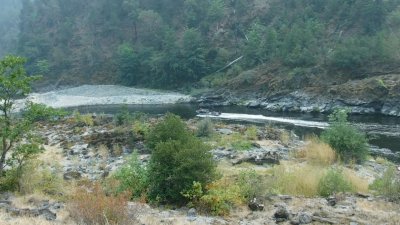
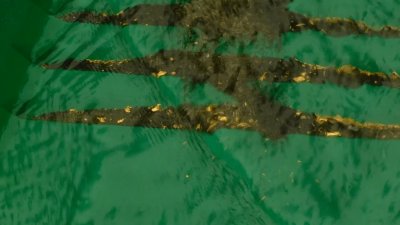
Having obtained pretty good results during the first two Weekend Projects of the season along our Sluice box property up near the town of Seiad, we decided to try something new this time. Longtime supporters, and always present to help, Scott Coleman and Laura Bagley had been telling me of a place that was producing good gold for them on the far side of the river down on the lower part of our Wingate property. This is about seven miles downstream from Happy Camp.
We only have a limited amount of time on these projects to confirm good pay-dirt. This is done using gold pans on Saturday afternoon. Then we will devote the cool hours of Sunday morning to process as much of the pay-dirt as we can.
Because we have so much mining property available to our members, sometimes it’s challenging just to decide where to go. To reduce the chances of not recovering very much gold on Sunday, it is common these days for us to pull a team of members together in advance to make sure the pay-dirt is actually present in the place where we will do the project.
There have been many times in the past that I found what appeared to be a valuable gold deposit because I recovered one or two good pans – only to return afterwards and discover that the place I recovered the gold was the only place it existed in volume. We made this mistake on a project many years ago and only recovered enough gold on Sunday that each participant just got a single flake of gold. While the members were gracious about it, because it is the nature of gold mining to not find good gold everywhere; I was terribly embarrassed to have gathered so many people for a group dig and we hardly found enough gold to spread around. Some mistakes you only need to make once in your life. This was one of them!
There are multiple reasons why all of our projects produce plenty of gold to go around these days. One reason is that we know the river a lot better. Another reason is that we have members like Scott and Laura that prospect every day and share the information with us. And the most important reason is that we pull a team together in advance of nearly every project and do enough sampling in the targeted area to be certain the gold deposit is large enough to sustain a group project.
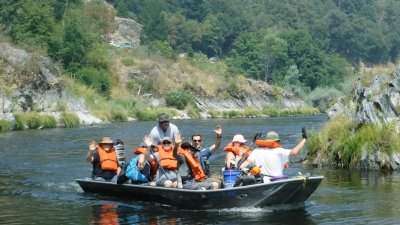 This took place in August. The river was really running low. So low, that we had to push my boat off the trailer at the boat ramp at Wingate. There have only been a few times over the years that we had to do that. Here it was on video:
This took place in August. The river was really running low. So low, that we had to push my boat off the trailer at the boat ramp at Wingate. There have only been a few times over the years that we had to do that. Here it was on video:
This location below Wingate was ideal because there was plenty of parking up by the road, a well-developed path down to the river, and just a short distance over calm water for us to ferry participants to the worksite. There was also a nice sand beach where we could land the boat and help people in and out of the boat.
Someone had told me that if we hike up the hill some distance, we would come upon the place where the Old-timers stopped mining. Supposedly, there is exposed bedrock there, and the ancient streambed is exposed directly on top of it. I’m told the pay-dirt is extremely rich. So this is where I assumed we were going when I first arrived over there and made the following video. So I was surprised when Laura and Scott stopped about half way up the hill and started sampling:
The place Scott and Laura had made a good discovery was up the hillside along a pretty good path. So that’s the first place Scott, Laura and I went. Each of us got good pans, and the flakes of gold were larger than we have generally encountered this season. Here is their explanation of the gold discovery and Scott’s single, unscreened pan on video:
Still, it was going to require all the pay-dirt to be packed in buckets some distance to the river. This is something to consider when evaluating any discovery: How much of your labor is going to be subtracted from digging and processing pay-dirt? In this case, I would guess that it would take only about half the time to fill buckets, than it would to pack the buckets to the river. But the gold was good enough that we still could have made it come out alright.

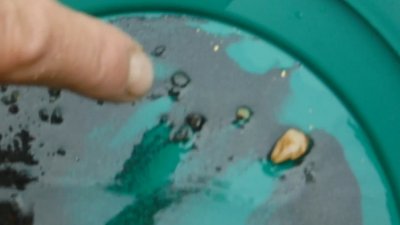
The flakes of gold were larger up the hillside.
Sure enough, the gold in Scott’s, Laura’s and my sample pans all had good gold for the small volumes of gravel we processed. Some of the pieces were mid-sized flakes. This is important because bigger pieces of gold weigh up on a scale better than even a good showing of fine (small pieces) gold. We have been fooled many times in the past turning up a good showing of fines, which added up in the recovery system on Sunday looking like we broke the all-time record of two ounces on one of these projects. Then, once we separated all those fine particles of gold from the other heavy minerals, the final result was much less than what we were hoping for. So there is a lot to be said about finding deposits that are made up of more than fine gold.
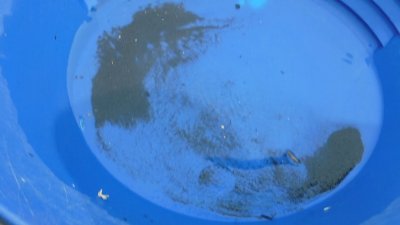
This is a good pan sample considering the small amount of streambed material that was processed!
The big surprise of the morning was when Craig Colt started recovering the best results of the day by digging into compacted sand that was being held together by a root structure of dead grass. This was right down by the river much closer to where we were going to process pay-dirt on Sunday. Here it all is on video:
Several others on the team were also turning up good gold down closer to the river. Derek Eimer found a gold nugget using his gold detector, and then lost it. Then he found it again! Finding even small nuggets in a gold deposit is always a sign that more will be present.
Craig moved slightly further up the hillside and attacked the packed sand again, this time finding a thin layer of brown compacted streambed resting over rough bedrock. His sample results from the natural streambed were the best yet!
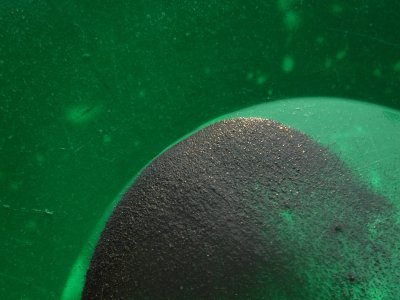
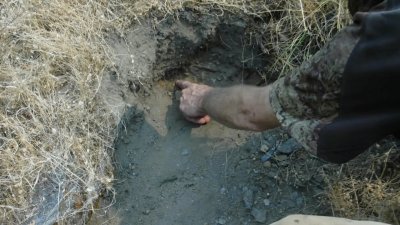
See the thin layer of natural streambed on the bottom just over bedrock?
We really don’t go out on these confirmation projects to mine gold. We just want to do enough sampling to be certain there will be enough gold to support a successful project. If the location is good, we will return the day before the project and use the boat to transfer all the gear to the site. Here was the moment when I decided we had accomplished our purpose:
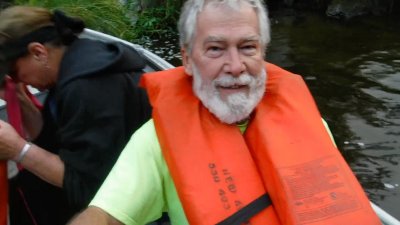
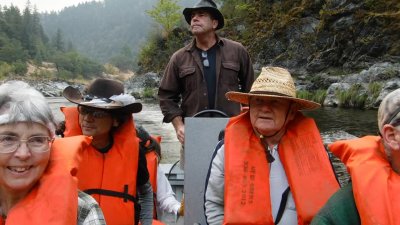
In any event, everyone on our small team was finding good gold in their samples at this new location; so we called it a day. In all, we devoted about an hour to confirming the location. That’s the advantage of having an experienced team of gold prospectors!
Our jet boat is a really important part of our infrastructure to support these projects. Without the boat, we would mostly be confined to the road-side of the river. The jet boat will allow us to go just about anywhere on the river. When we have large groups, sometimes we break out our large Colorado River rafts and tow whole groups of members up and down the river. Talking about adding a thrill to a prospecting adventure!
The truth is that besides developing rich gold deposits along the bottom of a river, there are few things that please me more than playing with boats on any kind of water. Here is some video that captured how much access the boat provides for us, and our gear, even moving our 300-pound floating recovery system up through several sets of rapids:
As group digs go, this one only had around 45 people. We are used to twice that many or more. But the terrible wildfires over the past several years have often made the air quality along the river so uncomfortable that there would be no fun in being there. The year before, the smoke was so bad that we were forced to cancel two of our Weekend Projects.
We were lucky on this particular weekend. The breeze was blowing smoke away from our work site. We could even see blue sky!
We always devote Saturday mornings at an air conditioned hall where everyone can sit down and relax. After introductions, I give a talk about the history of The New 49’ers which include some entertaining stories about events that happened along the way, and some of the colorful personalities who have been along for the ride – or took us for a ride, depending upon how you want to look at it. Then I make a presentation about how to follow a sampling plan to, step by step, work your way into high-grade gold. It’s not that difficult to make rich discoveries if you just stick to the plan! But it is human nature for beginners to stray from the plan and become discouraged. So I do my best to present the importance of following a sampling plan when looking for high-grade gold deposits.
The whole reason we do these weekend projects is to demonstrate to members that the gold deposits really do exist, and there is a very simple method (sampling plan) for finding them.
Saturday afternoon is all about teaching beginners how to pan for gold. We do this after lunch out on the discovery site. It took maybe 5 or 6 trips with my boat back and forth to get everyone over there. Providing the boat ride to these projects adds more color to the entire outdoor adventure. Here is some of the boat action on video:
We have done some projects where we had to tow everyone in through several sets of rapids to gain access to the work site, and then tow them down through two more sets of rapids to get them back to the road-side of the river! That was a lot of adventure; pretty-much the limit of what I am willing to put people through.
And to think in all these years, we only flipped over a boat full of people just one time…. Thankfully, nobody got hurt. No; I was not driving the boat; I was not even in the country!
Therefore, I do all or most of the boat driving these days!
There were only several beginners who needed some help with their panning skills on Saturday afternoon. Everyone was finding gold in their pans. This was a good place!
We don’t like to stay out very long on these hot Saturday afternoons. The main reason is that once the participants begin seeing the gold in their pans, they get jacked up and sometimes overdo it. Then they are too tired to come out on the cool Sunday morning when the real action is taking place. I’m sorry that there was some wind getting in the way of the audio on the following video, but you can still get the idea of how things were going out there:
But some of the members were so pleased with the gold they were finding, it was difficult to get them back into the boat. We talked several into filling buckets with pay-dirt so they could pan the material on the other side of the river.
One time, a member was so determined to keep on panning, he insisted that he would swim back across the river before dark!
We also do a potluck dinner and short meeting at 6:30 pm on Saturday evening. All members and their friends are invited to attend. These events are a lot of fun. People get to know each other in this setting. Many life-long friendships have been brought to life during our potlucks. I follow the meal with some instructions about when and where we will meet on Sunday morning.
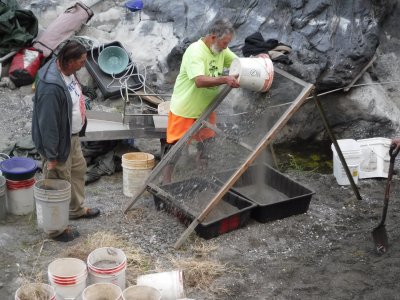
Longtime supportive member, Mark Turner, built a fairly large screening device that makes it more efficient to remove the larger rocks from the pay-dirt.
As uncomfortable as the alarm is sounding off at 5 am on a Sunday morning, the discomfort is nothing compared to attempting a serious group dig in the heat of an afternoon in August!
We meet down at the river access Sunday morning at around 6:30 am. It’s actually cold out there during that time of the day. By the time I went over in the boat for the last bunch of members, everyone had arrived. Normally I have to go back after a while and bring over a few stragglers. But not this time. These guys were jacked up to get some work done!
We could not sponsor these projects if we did not have around a dozen experienced members who volunteer their weekends to help out and be part of the fun. Even before I transferred everyone over the other side of the river, our experienced team had all the participants busy digging in the hotspots we confirmed the day before, filling buckets (half full) with the pay-dirt, running the material through a classification screen to eliminate the larger sized material; and then transferring the buckets of pay-dirt to the recovery system. I captured some of the action on video:
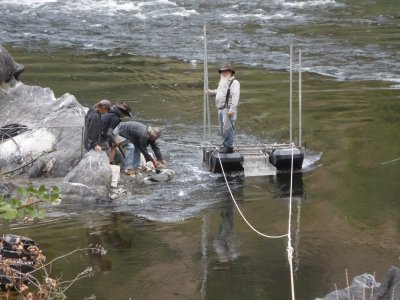
As this was a new place for us, it took a bit longer than normal to set up our floating sluice recovery system. This is a 6-inch modified dredge recovery system that we have set up on floats. There are adjustments to lower the front of the sluice just below the surface of the river’s moving water. The water then washes pay-dirt through the sluice. Gold, being around five times heavier than the average material we are processing, easily gets trapped in special gold traps (called “riffles”) along the bottom of the sluice.
Since it takes some skill to feed the pay-dirt into the recovery system at the right speed, we always allow Dickey Melton to do this job. He is very good at maintaining the balance of feeding as much pay-dirt as possible so we can recover more gold, while not overfeeding so much that the gold traps along the bottom become overwhelmed. If you feed too fast, the gold will never get exposed to the traps, and it is likely to run right through the sluice into the river. So Dickey probably has the most important job out there.
As it turned out, the water flow in this location was near perfect, because it was smooth, swift water just ahead of a set of rapids. The challenge turned out to be building a bridge of sorts, or at least a stable step, so that buckets of pay-dirt could be safely passed out to the recovery system. Here’s some video of when we were just getting things started:
By the time Dickey was satisfied the sluice was operating correctly, there were so many buckets of pay-dirt stacked up, there was no way he was ever going to catch up with the digging crew! This is the way we like it; never a moment when pay-dirt is not flowing through the recovery system! Here is the way it turned out on video:
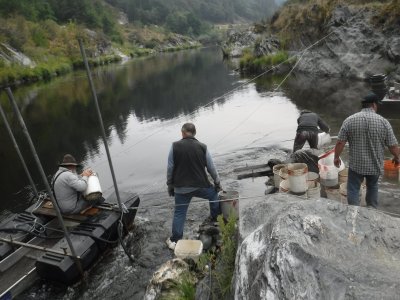
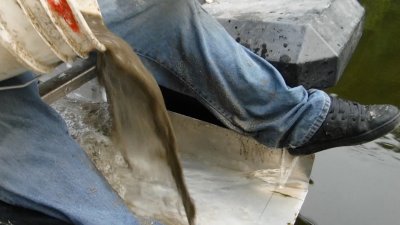
Dickey carefully feeding the recovery system. How about that view of the river; is that beautiful or what?
It was particularly cool on this August morning. Shoveling pay-dirt on a nice cool morning is rather easy. There was a lot of happy chatter out there on the side of the river. My sidekick, Diane took a moment to capture me on video providing an overview of what was going on:
Craig devoted some time going around and taking samples of the material people were shoveling into the buckets. Some samples were better than others; but everyone was digging in gold. If everyone is digging in gold, and we are producing enough pay-dirt to operate the recovery system at capacity for about four hours, I am always confident that there will be plenty of gold to go around when it comes time to split it up.
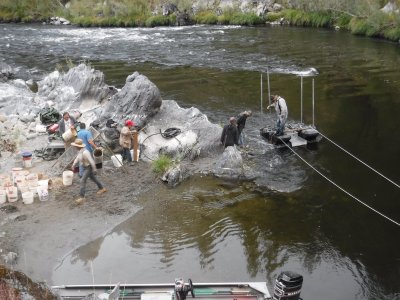
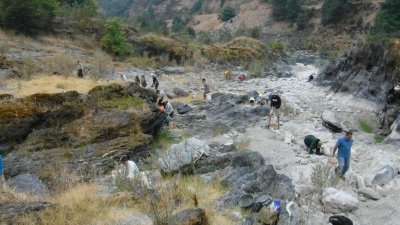
Here are some overall views of our work area; a very nice place to spend a Sunday morning!
The sun reaches the gravel bar along that portion of river at about 11 am. The heat of the day begins after noon. Since we still have to separate the gold from all the impurities back in Happy Camp and split the gold, we like to have everyone back across the river at around noon on Sunday afternoon. We give everybody some time to freshen up and usually meet for the final clean-up between 1:30 and 2 pm.
When we removed the riffles (gold traps) from the bottom of the sluice box to recover the material we had accumulated, there was a strong showing of gold present. We always get a good thrill out of that! Here is some video of Craig cleaning out the floating sluice:
The material we clear out of our floating recovery system out on the river is a mix of gold and mostly other heavy material. There is always plenty of black iron sand and small iron rocks. These also get trapped in the recovery system because they are heavy. We call this material “concentrates.” These other impurities must still be separated from the gold before we do the split.
We usually bring the final concentrate back to one of the meeting halls in Happy Camp for final processing. But wildfires in the vicinity had those all tied up for places to support the fire-fighting crews. So we did the final cleanup and split in the shade of a tree next to the picnic area along the side of our building.
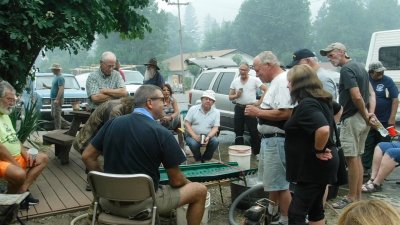
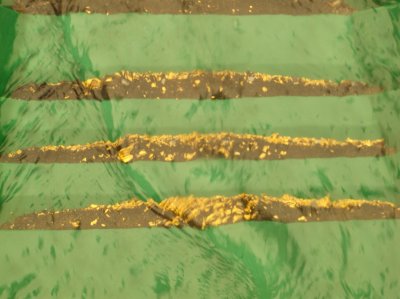
Our final clean-up steps begin with a Le Trap sluice box. This is a green plastic recovery system with low-profile riffles (gold traps) that recovers all our gold, but reduces about half a bucket of concentrates down to about a double handful. Final cleanup is always one of the most exciting parts of a successful gold mining program, because you get to see the thousands of pieces of gold add up in the recovery system. Here is a short video of my feeding the Le Trap:
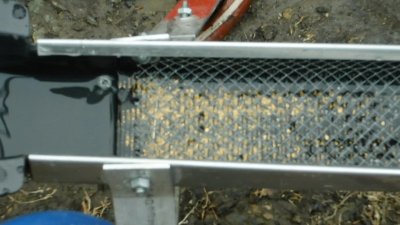
Here is our final cleanup in the Gold Extractor.
Our concentrates are passed through a #8 screen before we run them across the Le Trap. Then we run the smaller amount of concentrate over a Gold Extractor. This is an even smaller sluice with much smaller gold traps. When set up properly, neither the Le Trap or Gold Extractor will lose a single piece of gold no matter how small, unless there is some anomaly – like the gold still remains attached to a piece of rock. We captured some video of the Gold Extractor working, and then when that part of the process was complete:
For the benefit of anyone’s doubt, both Craig Colt and Derek Eimer carefully pan the tailings from both devices and show the results to the onlookers. There were no losses on this project!
The Gold Extractor reduces the concentrate down to about a tablespoon volume of gold and impurities.
All material that remains on top of a #8-sized screen are taken by our project supervisor, John Rose. Under his supervision, several participants use tweezers to pick out all the small nuggets. The nuggets are placed with the remaining concentrate and heated up in a small metal pan just hot enough to dry them.
Once dry, the concentrates are passed through a series of different sized (opening size) classification screens. Between the use of a magnet (to remove magnetic iron sands), and some light blowing, each size-fraction of the gold is finally separated from all the impurities.
It is very important to witness these final clean-up steps. It’s already challenging enough to locate and develop a high-grade gold deposit. But reducing the concentrate to where you have the finished product of just gold is something that requires some practice.
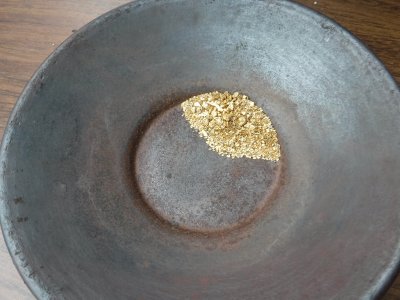 Every gold deposit is different in the size ratios of gold particle size. Perhaps because most members were cleaning out bedrock cracks alongside the river, we recovered an unusual number of small gold nuggets – 37 in all. This was an amazing number of nuggets to find on one of these projects. Here is John Rose on video, who was so excited by the number of nuggets, that he was compelled to go outside and show everyone even before he was finished:
Every gold deposit is different in the size ratios of gold particle size. Perhaps because most members were cleaning out bedrock cracks alongside the river, we recovered an unusual number of small gold nuggets – 37 in all. This was an amazing number of nuggets to find on one of these projects. Here is John Rose on video, who was so excited by the number of nuggets, that he was compelled to go outside and show everyone even before he was finished:
The final split was between 31 participants, so everyone received at least one nugget. To put this in perspective, even though we recovered more gold during other earlier weekend projects at Sluice box, I believe we only recovered a single gold nugget between those two projects.
The total weight we recovered at Wingate amounted to 264 grains – which amounts to about 11 pennyweights – just over half an ounce. While the volume of gold was less than during the earlier projects, the number of people out there digging was much smaller. This afforded everyone with a share weighing 8.5 grains. The usual split amounts to around just over 6 grains each. So we actually broke a record for the number of people on the project! Everyone seemed more than happy with that.
With another successful Weekend Project behind us, we all said our farewells and broke up at around 4 pm on Sunday afternoon.
Cherished Member, Alex McCrone, has Moved on at 11 Years of Age
The following is shared with us from his loving dad, Paul McCrone:
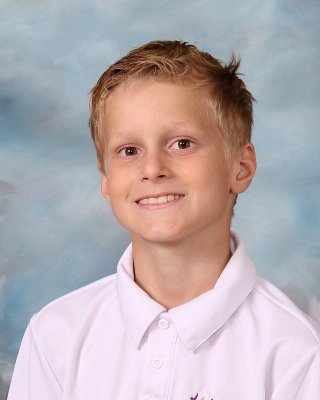 Alexander Paul Julian McCrone: 9/15/2006 – 7/27/2018
Alexander Paul Julian McCrone: 9/15/2006 – 7/27/2018
Alex was born on September 15, 2006 in the wake of a tornado…. literally…a Nebraska tornado hit the day after he was born. The devastation was bad enough that Baby-Alex and his family were evacuated.
Alex rested gently in the loving arms of Jesus on Friday, July 27, 2018. But the tornado of Alex’s spirit will live on in all of us who knew him and continue to love him.
There are few people who have faced life’s trials as gracefully and courageously as Alex did. Diagnosed with cancer at age four, he triumphantly beat the cancer monster twice and continued to live his life fully, infusing each moment with his family and friends with all the love possible.
A free-spirited philosopher well beyond his years, Alex taught us how to love, how to say, “I’m sorry,” and how to forgive. Alex wanted everyone to get along and appreciate one another. He loved to be active, playing baseball, swimming, doing karate and sharing his Pokémon cards with anyone who would play.
During his final days, Alex spoke words of wisdom to share far and wide: “A world without love is impossible.”
Every year during his time in school, Alex received well-deserved awards and recognitions including the Loyalty Award in second grade and the Character Quality Award in fifth grade. He enjoyed karate at the Fierce Tigers Martial Arts in Salinas.
Alex loved mining for gold! It was something he asked me, “Dad, when are we going MINING again?” He loved the glint of gold, and he always lit up whenever he got some.
Alex lit up a lot; he was better at panning than his Dad is! He seldom came away without some gold. Alex has the McCrone family record for finding the largest gold nugget.
Alex was in love with the Klamath River and the beauty of the Happy Camp claims, out of the town, in the forest, watching animals; the entire outdoor experience.
We loved going to the New 49er Saturday potluck meetings, with good food and friends, sharing what happened, listening to the tales. Those were truly some magic times we shared that I will never forget!
Note from Dave: Many of you who have attended our weekend prospecting projects during recent years will remember Alex. There was a long stretch there when they never missed a single outing.
Keeping the secret of Alex’s condition to themselves, there was never a time when I saw anything but a gracefulness between father and son and genuine kindness and gratitude towards the rest of us.
As I find myself getting older, I am losing more and more of the people I care about. I often feel a twinge (or in some cases, a lot) of guilt for not making my encounters as good as they should have been if I had known they were coming to an end. Finding a way to adjust to these losses is one of my own greatest challenges. I will miss Alex a lot!
Legal/Political Update
I ended off my September comments basically with the following:
Here is my prediction: If the Trump agenda manages to move forward, the Trump Team will ultimately overcome the stranglehold which America’s domestic enemies (inside all levels of government) who are determined to burn America’s forests down (and now entire rural communities), rather than return to sustainable forest management that creates wealth and prosperity for all Americans. This management approach will include us as small-scale gold miners who recover true wealth for America, remove mercury, lead and other toxins from the country’s waterways, and create prosperity for rural communities.
Even though the Republicans have lost their majority in the House of Representatives, as long as the Democrats do not succeed in wrestling away control of the U.S. Senate through the election shenanigans going on in several States, my prediction above remains the same. All of the important endorsements required to appoint federal judges and top level officials (like Attorney General) originate out of the U.S. Senate where it appears that the republicans picked up several seats.
There was not any meaningful mining law reform legislation moving through congress anyway. With the Senate and House split between republicans and democrats, and Mr. Trump remaining in charge of the Executive branch of the federal government, we can be certain that new laws at the federal level that will be harmful to working class Americans are unlikely to go anywhere.
Meanwhile, Mr. Trump will continue to move his “Make America Great Again” agenda forward by reforming and reducing the negative impact upon us from federal agencies through executive order, much like Obama did when he could not get cooperation from the Republicans in congress.
I do predict that the democratic-controlled House of Representatives is going to do everything they can to make Mr. Trump’s life even more uncomfortable, along with the closest supporters on his management team. Little or none of this should materially interfere with the Trump Team’s efforts to reform the federal agencies. None of this should affect ongoing litigation between some States and the federal government over who ultimately controls resource development on the public lands.
The democrats may begin impeachment proceedings against Mr. Trump, because this just requires a majority in the House. However, the trial would take place entirely by the republican-controlled Senate, and would require a finding by 2/3’s majority of high crimes and misdemeanors. The chances of this happening are about zero. Impeachment proceedings, while distracting, may be the fastest way to get the past two years of Russia Collusion allegations finally resolved in Mr. Trump’s favor.
I saw on today’s national news that Mr. Trump is blaming the federal agencies in a very big way for the wildfires that are ravaging the west. This would seem to be a sign that new management policies are coming that will perhaps return to multiple use management, rather than conservation. If and when this all ends up in front of the existing U.S. Supreme Court, it really should go our way. Why burn entire forests and communities down, when the alternative is to sustainably develop them while creating wealth and good jobs?
On another note, we should not be surprised that the Ninth Circuit Court of Appeals ruled against miners in the BOHMKER v OREGON case in which the miners are challenging a State’s authority (in this case, Oregon) to prohibit mining on the federal lands.
The New 49’er Legal Fund has offered to help with the costs of Petitioning the U.S. Supreme Court for Review.
Now we can only hope that the Trump Team has been busy replacing the Obama officials in the justice department who review the thousands of cases sent to the U.S. Supreme Court. Our Rinehart case, which basically raised the same question over who ultimately controls the federal lands, made it to the final list several months ago. But it was rejected mainly on the grounds that this BOHMKER v OREGON case was better suited for the high court to review. Let’s all collectively cross our fingers on this one!
While we wait, it appears that the California Water Board intends (perhaps intended) to adopt a Statewide water quality permit that will (perhaps) allow suction dredging under Section 402 of the Clean Water Act. I discussed this in my last newsletter. Nothing on this has changed, except it would appear that they have fallen behind schedule. Last I heard, they were going to put out a public disclosure in early October. I have yet to see anything. Several other industry leaders have been sending them queries; but so far, there have been no answers.
Legal Drawing Winners
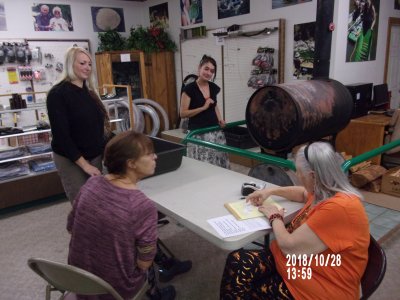 Here is the winning list from the legal fund drawing 10-26-18
Here is the winning list from the legal fund drawing 10-26-18
Veronica Rasmussen was our helper on this drawing.
Ten 1-ounce American Silver Eagles: Ryck Rowan of Spokane, WA; Donald Hill of Vallejo, CA; John Willett of Porter, ME; Gradley Hughes of Riverside, CA; Jolynn Ruedas of Vacaville, CA; Ryck Rowan of Spokane, WA; Kenneth Parchinski of Alford, FL; John Stewart of Canton, CT; Bill Dimmett of Redwood Valley, CA; & Tracy Seeger of Puyallup, WA
Ten 1/10th-ounce American Gold Eagles: Jerry Rady of Escondido, CA; Ken Wilson of Australia; Terry & JoAnne McClure of Quartzsite, AZ; Ernest Nelson of Imperial, CA; Karl Leabo of Florance, OR; Dennis Zander of Klamath Falls, OR; Ralph Wiser of Reno, NV; Richard Davis of Valley Center, CA; Michael OConnell of Crescent City, CA; & Steven Gonzales of Burlingame, CA
Four ¼-ounce American Gold Eagles: James Steffens of Las Vegas, NV; Ryck Rowan of Spokane, WA; Steven Eichman of Portland, OR; & Molnar Peter EV Budapest, Hungary
Grand Prize: 1-ounce American Gold Eagle: Matt Cottrell of Galt, CA
Congratulations to all the winners.
Thank you to everyone who is helping us to preserve small-scale mining in America!
Next Legal Drawing will Have Alaskan Gold Prizes!
In a wonderful gesture of generosity, Tamarand Campbell has donated two ounces of gorgeous natural gold that was recovered during Discovery Channel’s “Gold Rush” reality show on television! We have received the gold. We will follow soon with an image.
This is very cool!
This gold will be divided into multiple prizes, along with 10 tenth-ounce American Gold Eagles and 10 one-ounce Silver Gold Eagles in our latest Legal Fund drawing which will take place on 22 February 2019!
Legal contributions can be arranged by calling (530) 493-2012, by mailing to The New 49’ers Legal Fund, P.O. Box 47, Happy Camp, CA 96039, or online by clicking Here.
Your contribution to The New 49’er Legal Fund is tax-deductible.
2018-19 Winter Office Hours
Unless there is some kind of emergency like a wild fire, our mining properties are always open to New 49’er members 24 hours per day, 365 days per year.
To conserve financial resources during the winter months when there is so little walk-in traffic, we have reduced walk in office hours to 9 am through 4 pm, Monday, Tuesday and Friday. These new office hours will begin on 1 October.
There is a phone message service if you call at a time when the phone is not being answered.
Reminder that we have an emergency Internal Affairs telephone connection that works all of the time by calling Rich Krimm at (510) 681 8066. Please do not use this number in an attempt to discuss routine matters! It is for emergencies only.
Sign up for the Free Internet Version of this Newsletter
We strongly encourage you to sign up for the free on line version of this newsletter. This is because you can immediately click directly to many of the subjects which we discuss; because the on line version is in full color; because we link you directly to locations through GPS and Google Earth technology; and because you can watch the free video segments which we incorporate into our stories. Actually, the video segments show the adventures better than we can write them!
Signing up also places you on our Political Action Team. Things happen so fast these days; it takes too long to organize political action through the U.S. mail. As an example, by contacting our supporters this way, in a matter of hours, we recently generated a large bundle of letters to the California Supreme Court. All of these future battles will be organized over the Internet since it is so much faster. Please join us in the battle to maintain our remaining freedoms!
Sign up for our Free Internet Newsletter!
Note: You are free to unsubscribe anytime just by clicking a link if you decide to do so.
New 49’er Gold Prospecting Association
27 Davis Road P.O. Box 47, Happy Camp, California 96039 (530) 493-2012
www.goldgold.com



